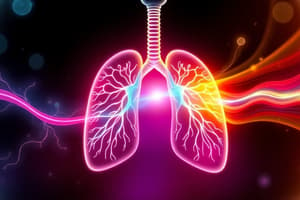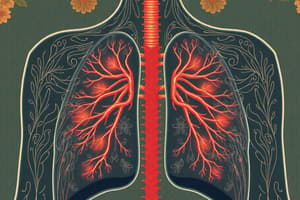Podcast
Questions and Answers
Describe and differentiate between external and internal respiration.
Describe and differentiate between external and internal respiration.
External respiration moves gases from outside of the body into the lungs, and then into the blood. Internal respiration is the gas exchange between the blood and the tissues. Both processes are linked through the circulatory system, facilitating the delivery of oxygen to tissues.
Describe the mechanisms involved in inspiration and expiration.
Describe the mechanisms involved in inspiration and expiration.
Inspiration involves the intercostal muscles and the diaphragm, moving the ribs and sternum while the diaphragm contracts and flattens. Expiration is the relaxation of the elastic recoil of the lungs, with the diaphragm returning to its normal position and the intercostals relaxing.
What is a spirometer? Describe and define the lung volumes measured using spirometry.
What is a spirometer? Describe and define the lung volumes measured using spirometry.
A spirometer is a tool used to measure volumes of inspired and expired air. Key lung volumes include tidal volume (amount of air for one breath), vital capacity (greatest amount of air expired after maximum inspiration), and residual volume (air remaining after maximal expiration).
Explain the concept of partial pressures of respiratory gases.
Explain the concept of partial pressures of respiratory gases.
Where in the lung does the exchange of gases with the blood occur?
Where in the lung does the exchange of gases with the blood occur?
How are oxygen and carbon dioxide transported in the blood?
How are oxygen and carbon dioxide transported in the blood?
How is oxygen unloaded from the arterial blood to the muscle and carbon dioxide removed from the muscle?
How is oxygen unloaded from the arterial blood to the muscle and carbon dioxide removed from the muscle?
What is meant by the arterial-mixed venous oxygen difference?
What is meant by the arterial-mixed venous oxygen difference?
Describe how pulmonary ventilation is regulated.
Describe how pulmonary ventilation is regulated.
Define the term 'inspiration'.
Define the term 'inspiration'.
Define the term 'expiration'.
Define the term 'expiration'.
What is pulmonary diffusion?
What is pulmonary diffusion?
What is Dalton's law?
What is Dalton's law?
What does TLC stand for?
What does TLC stand for?
What does VC stand for?
What does VC stand for?
What does TV stand for?
What does TV stand for?
What does IC stand for?
What does IC stand for?
What does IRV stand for?
What does IRV stand for?
What does EC stand for?
What does EC stand for?
What does ERV stand for?
What does ERV stand for?
What does RV stand for?
What does RV stand for?
What does FEV stand for?
What does FEV stand for?
What does FVC stand for?
What does FVC stand for?
What does FER stand for?
What does FER stand for?
What does PEF stand for?
What does PEF stand for?
Flashcards are hidden until you start studying
Study Notes
External and Internal Respiration
- External respiration involves gas exchange from the environment to the lungs, then to the bloodstream.
- Internal respiration refers to gas exchange between the blood and body tissues.
Mechanisms of Breathing
- Inspiration engages intercostal muscles and the diaphragm, lifting the ribs and flattening the diaphragm.
- Expiration is a passive process where elastic recoil of lung tissue causes air to exit as muscles relax.
Spirometry and Lung Volumes
- A spirometer measures inspired and expired air volumes, indicating lung capacity changes.
- Key lung volumes include:
- Tidal Volume (TV): air exchanged in normal breathing.
- Vital Capacity (VC): maximal air expelled post-inspiration.
- Residual Volume (RV): air remaining after maximum expiration.
Partial Pressures in Gas Exchange
- Partial pressure reflects the individual pressure exerted by each gas in a mixture, critical for gas exchange.
- Oxygen constitutes 20.93%, CO2 0.03%, and nitrogen 79.04% of air, establishing a pressure gradient for diffusion.
Gas Exchange Location and Mechanism
- Gas exchange occurs at the respiratory membrane, composed of alveolar and capillary walls.
- A pressure gradient facilitates diffusion of gases across the membrane.
Transport of Gases in Blood
- Oxygen is transported bound to hemoglobin or dissolved in plasma.
- Carbon dioxide is carried as bicarbonate ions, dissolved in plasma, or bound to hemoglobin.
Oxygen Unloading and CO2 Removal
- Myoglobin in muscle cells transports oxygen to mitochondria, releasing it when tissue PO2 is low.
- CO2 diffuses from muscle cells into the blood for transport back to lungs.
Arterial-Mixed Venous Oxygen Difference
- This difference measures oxygen content between venous and arterial blood.
- During exercise, active muscles require more oxygen, leading to a greater difference.
Regulation of Pulmonary Ventilation
- Respiratory centers in the brain stem regulate breathing rate and depth by responding to changes in CO2 and H+ levels.
- Increased breathing occurs during exercise to expel excess CO2 and H+.
Definitions of Key Terms
- Inspiration: Active process involving diaphragm and external intercostal muscles.
- Expiration: Passive process involving muscular relaxation and lung elastic recoil.
- Pulmonary Diffusion: Gas exchange across the alveolar respiratory membrane.
- Dalton's Law: Total pressure of a gas mixture equals the sum of individual gas partial pressures.
- Total Lung Capacity (TLC): Total volume of air lungs can hold.
- Forced Vital Capacity (FVC): Volume of air expelled forcefully after maximum inhalation.
- Peak Expiratory Flow (PEF): Maximum flow rate during early forced expiration.
Studying That Suits You
Use AI to generate personalized quizzes and flashcards to suit your learning preferences.




